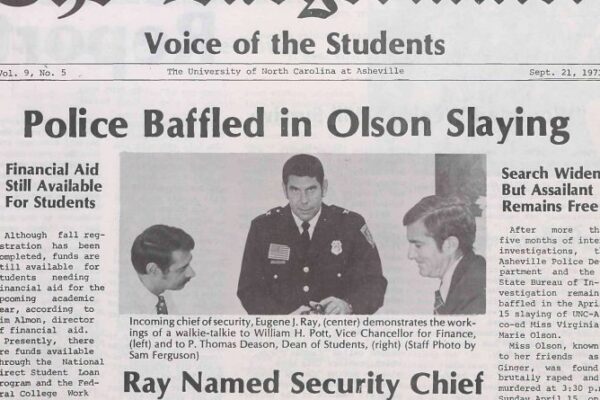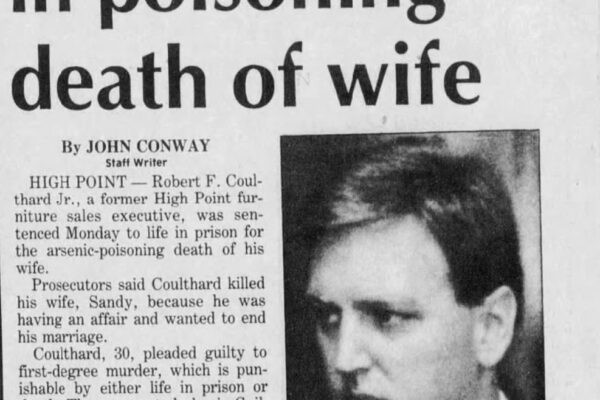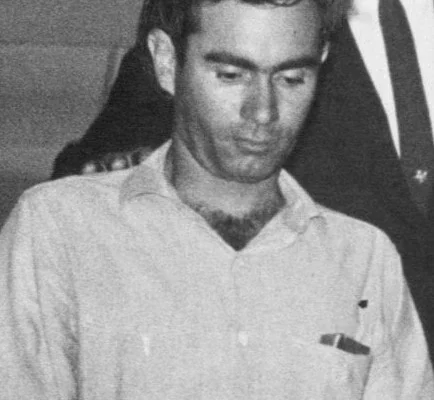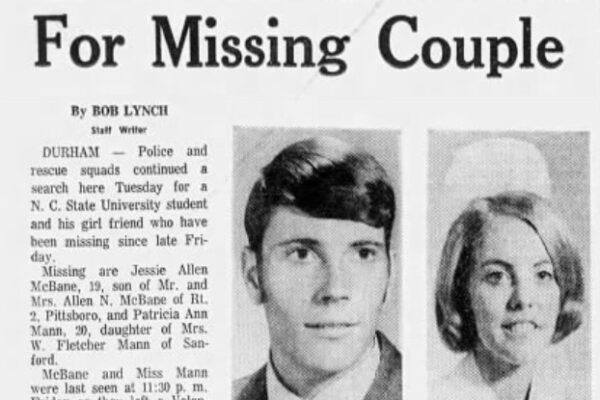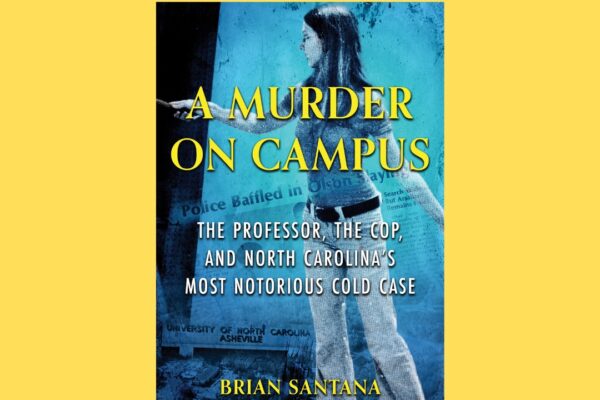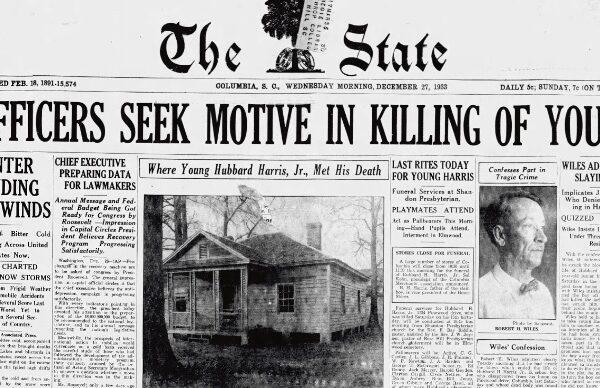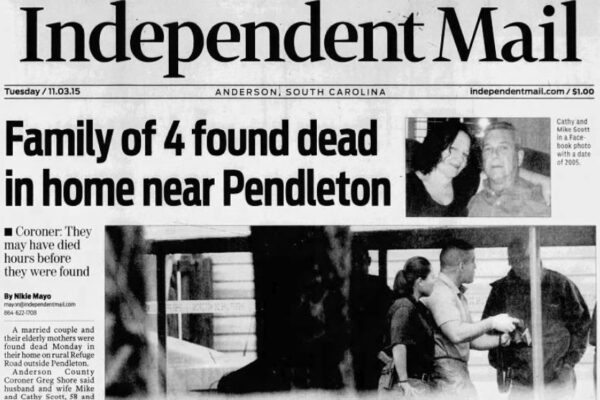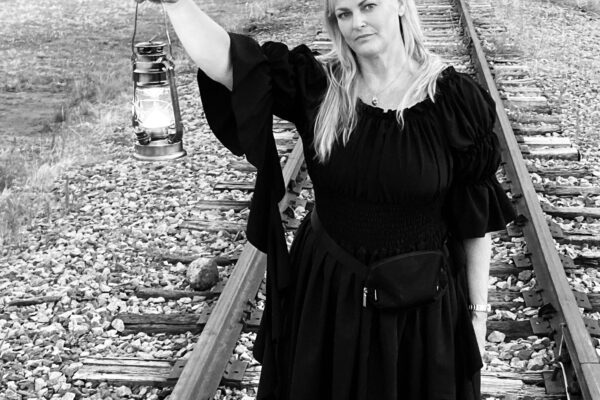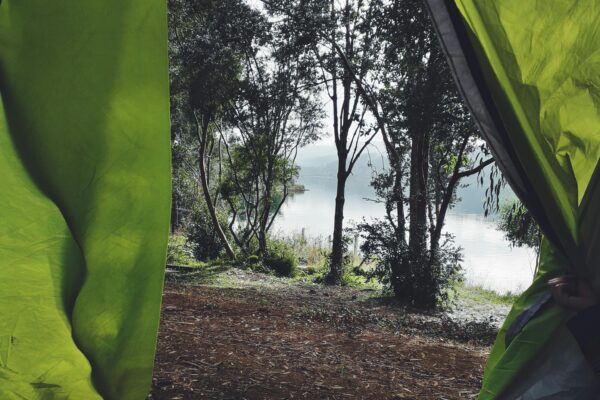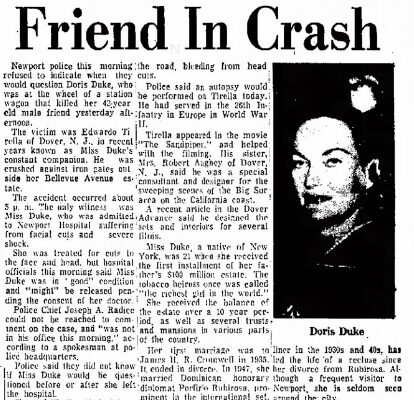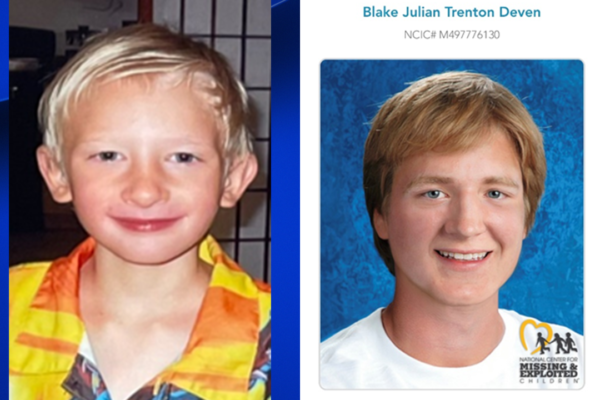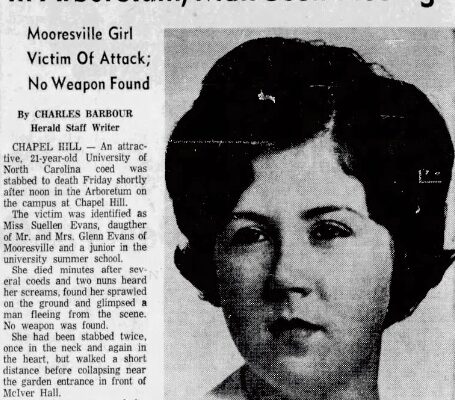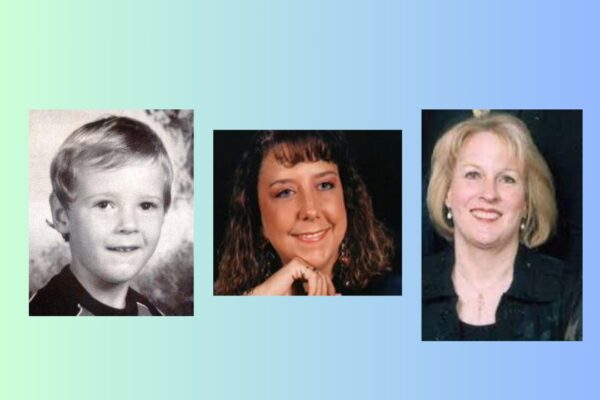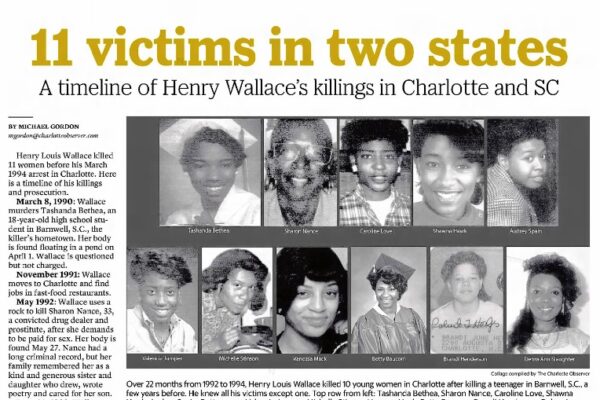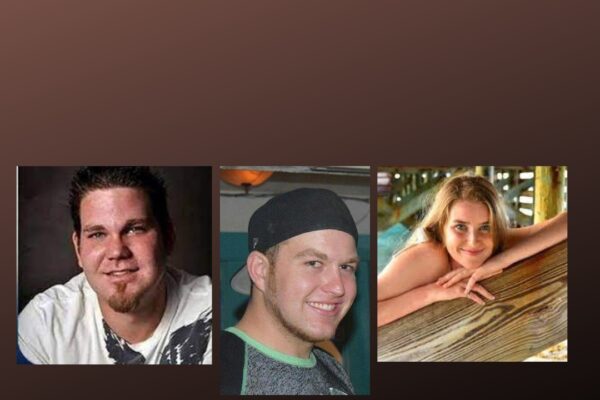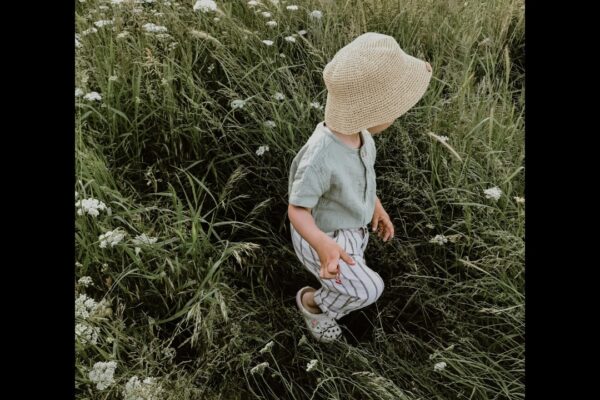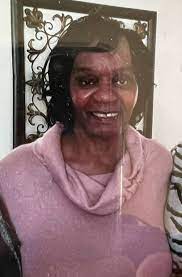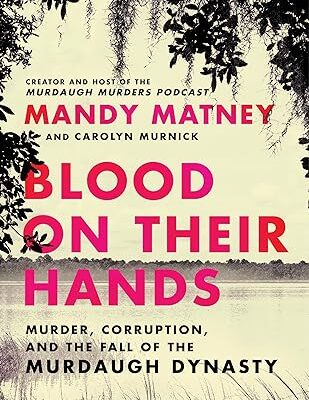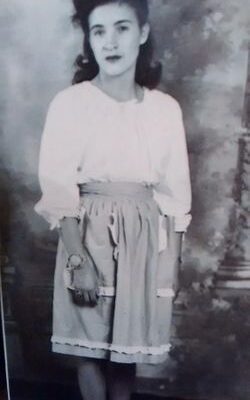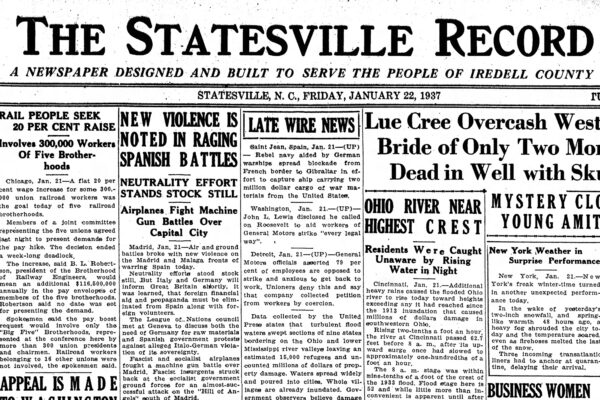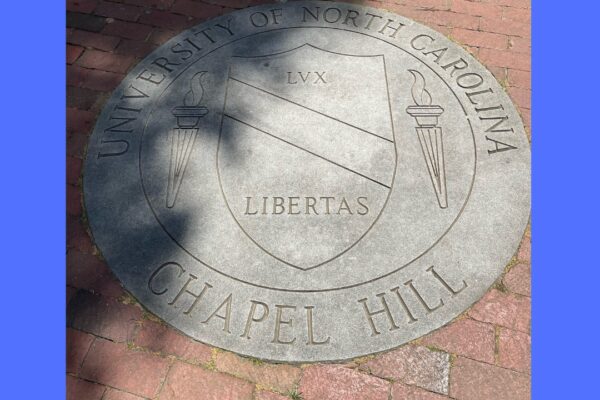On the morning of Sunday, April 15, 1973, Virginia Olson, known as “Ginger” to her friends, awoke on a chilly morning in the Craig Dormitory, located on the campus of UNCA, nestled in the mountains of Western North Carolina. A sophomore dramatics major, Ginger was known for enjoying her alone time. She liked to read, go on long walks, paint and sketch, and play her guitar. Ginger had grown up in McLean, Virginia, but graduated from high school in Lexington, North Carolina after her father, C. Doswell Olson, took a new job working as a research technician for the Rural Electrification Administration. She was dating a young man named Jeffrey Doyle who was a student at the College of William and Mary in Virginia. She’d worked the previous summer as a lifeguard at a swimming pool with a private swim club, where her employer spoke highly of her character. Ginger was looking forward to applying for a summer job at the local playhouse after classes ended.
Ginger wanted to spend the afternoon studying outdoors in the nearby botanical gardens. She put on a green t-shirt, a checkered flannel shirt, blue jeans, and sneakers. She selected her books and said goodbye to her roommate, a young woman named Jane Nicholson. Between noon and 1 p.m. she headed to her destination, stopping to speak with a few fellow students on the path near the dorms that led to the gardens. However, over the years, people studying this case have speculated that the botanical gardens may have been too crowded for Ginger’s taste. She headed out of the main area, selecting a quiet spot on a hill in a nearby densely-wooded patch of land. Ginger had no idea predator was lurking in the trees. Around 3:30 p.m., two local high school students, 14-year-old Thomas Guthrie and 17-year-old Larry O’Kelly, were walking through the woods when they came across a horrifying scene.
The Discovery
Ginger was lying face-up in the middle of the path, and her green t-shirt had been ripped and used to bind her and gag her mouth. She had been stabbed in the chest and her neck slashed. Other pieces of her clothing were scattered around the area. Her personal journal sat nearby with her wire-rimmed glasses placed upon it.
The Friday before the murder Ginger’s parents had come through town on their way to visit family in Dudley, Missouri. They stopped and had a visit with their daughter, and then continued on. They received a call on Sunday morning that Ginger had been murdered.
When her friends from Lexington learned of the murder, they were shocked. One told a reporter with the Greensboro Daily News that Ginger was “the sort of person who trusted everyone, but if she found out she was wrong, she wouldn’t hate them.”
A 19-year-old young man visiting the area from Richmond, Virginia, was arrested the day after the murder for breaking into the Greek Hellenic Community Center. He was questioned about Ginger’s death but was later released after police verified his alibi.
Very early on, police questioned a man they felt was a strong suspect in Ginger’s murder. According to reporting by the Asheville Citizen Times, he was a 45-year-old white male who rented an apartment within walking distance of the crime scene. On the day of a murder, he met up with a friend who drove him around North Asheville, including the Botanical Gardens. The suspect pointed out a young woman who was sitting on an embankment overlooking the garden. The time frame for this occurrence would have been around 1 p.m. Police believed this must have been Ginger. The suspect’s friend then dropped him back near his apartment on Merrimon Avenue near Hillside Street. A female neighbor told police the suspect came to her apartment around 2:40 p.m. that day. He was nervous, and wanted “someone to pray with him.” He went to another neighboring apartment and complained to the resident that something was “a bloody mess.”
A few years after the murder, police interviewed a new witness about something she had seen on the afternoon of April 15, 1973. She was walking her dog in the Botanical Gardens when she saw a man walk out of the woods, run down the embankment, cross WT Weaver Boulevard, and walk up a grassy hill leading to UNCA’s campus. That embankment was where Ginger’s body was found.This was between 2:30 and 3:30 p.m. She described him as being a “big person, though not particularly tall,” and stated he was wearing brightly-colored clothing. She thought he was around 25 years old. Other witnesses also reported seeing a man walking up the embankment where Ginger was murdered, and they also said he was sitting with a young woman up at here at one point. A man who was parked near the gardens that afternoon so he could listen to an auto race on his radio, said he saw a man walk up to the area where Ginger had been found slain. He described this man as 23 to 24 years old, wearing dark paratrooper-style boots, standing about five feet ten inches tall and weighing around 165 pounds. Both this witness and the woman walking her dog said he appeared to have something on his back, like a small backpack or a sweater tied around his neck.
The woman who prayed with the suspect at the apartments said he had a sweater tied around his neck and was wearing brightly-colored clothing and dark boots. While the suspect was 45 years old, the witness described him as being younger. The police said the man looked younger from a distance, which may have confused the witnesses when estimating his age.
After his distressing behavior at the apartments, the suspect then drove to Myrtle Beach, South Carolina, and checked into a motel there on April 17, two days after the murder. He stayed there until April 28, when he returned to Asheville. Police questioned him the next day upon his return and searched his apartment. They took a pair of brown Dingo boots, a white T-shirt, a yellow velour shirt, a kitchen knife, and a white handkerchief. These items were sent to the State Bureau of Investigation Crime Lab in Raleigh for analysis, but the police said the results of the tests came back negative. I’m not sure what they tested negative for, but I’m assuming it was blood.
This suspect was not a native of Asheville. In fact, police learned he was under the care of a psychiatrist in Asheville at the time of the murder, and there are rumors that the suspect was in outpatient treatment at nearby Highland Hospital. This psychiatrist declined to speak to the police about the suspect, citing doctor/patient confidentiality, and then passed away within a few years.
Highland Hospital
Highland Hospital has a long and storied history. A physician named Dr. Robert S. Carroll founded the facility in 1904, and it was known as Dr. Carroll’s Sanitarium. It was touted as offering “superior accommodations for the limited number of Nervous, Chronic, and Drug Habit Cases.” A few years later, the facility relocated from its location on Haywood Street in downtown Asheville to Zillicoa Street. It sat on 38 acres and eventually two more buildings were added. In 1912, it was renamed Highland Hospital.
It advertised itself as having amenities that could be found in a hospital, sanitarium, and home, including steam-heated rooms and open fireplaces. It had a swimming pool and offered massage and electric treatments. The Asheville Citizen Times reported that physical activity was a large part of the hospital’s program. Here’s a direct passage from the article:
“In addition to music, reading and parlor games, tennis and other outdoor sports for which there is ample room, drives unsurpassed in beauty and variety, horseback riding over perfect roads and through scenes of unrivaled diversity, with climbs which invigorate, strengthen and inspire are provided for the patients. Trips to surrounding points of interest are arranged from time to time, tramps along trout streams, hunting excursions in the mountains, camping parties, climbing expeditions, anything that will bring back the bloom of health again to the cheek, and the old vigor to the weakened constitution.”
There were additional guidelines imposed on the female patients during the early years of the hospital. Dr. Carroll forbade the use of mirrors, as he felt “that primping in front of them, as well as using rouge and lipstick, were false modes of concentration on the self.”
Incidentally, George Vanderbilt felt the same way about Asheville and designed his family’s mansion, The Biltmore Estate, with the dream of hosting friends and family in the cool mountain area, where they could swim, hike, ride horses, and enjoy the outdoors. Many physicians at the time believed this type of natural treatment could cure a number of ailments. Construction on that estate began in 1889. During this time period another doctor also opened a sanatorium designed for the treatment of tuberculosis in the Kenilworth area of Asheville.
But back to Highland Hospital. In 1939, Dr. Carroll donated the facility to Duke University, but he remained the medical director there until his retirement of January 1945. A frequent patient at Highland Hospital was Zelda Fitzgerald, the wife of author F. Scott Fitzgerald. In 1948, an electric coffee urn in the hospital’s central building started a fire. Investigators believed the fire spread through the kitchen and up a dumbwaiter to all four floors. The facility had fire escapes, but many of the screened porches and windows were shackled with chains to keep patients from jumping out. There was no sprinkler system. Nine patients, including Zelda Fitzgerald, died in the fire. Eleven patients were rescued. That building on the property was never rebuilt, and today there is a granite memorial that contains the following quote from a letter Zelda wrote to Scott:
“I don’t need anything except hope, which I can’t find by looking backwards or forwards, so I supposed the thing is to shut my eyes.”
Psychiatric Institutes of America purchases Highland Hospital in 1981, and the hospital closed in October of 1993.
An associate of the primary suspect’s father, who was the head of a prominent law firm up north, arranged to have him flown out of Asheville shortly after the police questioned him. At the time the 1976 article was published, his last known address was a mental hospital near Boston, Massachusetts.
People in the Garden
There were two other persons of interest in the area of the botanical gardens that day. A witness from Hendersonville who was visiting the area with his wife and another couple said he saw a young woman sitting with a man on top of the embankment. But he described the man as wearing a green army fatigue jacket, and this was different than the man with the sweater tied around his neck and wearing beige slacks. This group also said they saw another white male walking past the gardens toward the university campus around 2:30 p.m. as they were on their way out. This man was described as “rather tall and thin, wild-eyed and in his early 20s.
Police knew who this “wild-eyed” suspect was. They said he was employed as a gardener by the university and had a history of emotional and mental problems. They told the Asheville Citizen-Times reporter that another suspect, a Marine, had been staying at a motel on Merrimon Avenue. This man could have also fit the military dress description, and they also pointed out that it was not unusual at that time for any men in their 20s to be dressed in Army boots or a fatigue jacket. I have to wonder if the witnesses saw two or three different men in the area of the botanical gardens on the afternoon that Ginger was murdered, and that would explain the conflicting descriptions.
Exactly one year after Ginger Olson’s murder, another female UNCA student went missing. An 18-year-old freshman from Buffalo, New York was living with an aunt in the Skyland area and commuting to the university. She failed to return home as usual on Friday evening and was reported missing on Saturday. Her parents had arrived in town to pick her up for an Easter trip to Florida. Police began searching the campus, including the secluded spot near the gardens where Ginger was murdered. On Monday, the student, who I’m going to call K., showed up near a construction site near the Asheville Civic Center downtown and begged for help. Once she was taken to the local hospital she gave her statement to the police.
K. said she had received a ride on Friday afternoon from a classmate to the downtown Pritchard Park area. She was then approached by a young woman near the Woolworth’s Department store and recruited to be interviewed for a magazine article. She was taken to an apartment where the woman pulled a knife. While there, K. was sexually assaulted by a male accomplice. On Monday, she managed to escape by stabbing the female captor in the hand with a fork. 17-year-old Louise Bray and 19-year-old Walter Smith, who lived on Cherry Street, were charged with rape and kidnapping in the incident that police deemed an unusual coincidence in the anniversary to the Olson murder.
On September 6, 1974, the Asheville Citizen Times reported that a member of the Asheville Police Department and the North Carolina State Bureau of Investigation had been dispatched to make arrangements to question a man being held in northern Florida for a series of rapes. They discovered this man had been a student at UNCA in 1969, and was living in the vicinity of the campus when he served time in Buncombe County for some burglaries. This suspect was eventually ruled out.
Tracking Down Lead Suspect
In 1984, The Asheville Citizen Times reported that members of the Asheville Police Department were heading to Santa Fe, New Mexico to speak with a man who was questioned and released two weeks after Ginger Olson’s murder. I believe this suspect was the man dressed in brightly-colored clothing residing in the apartment near campus—the one who asked his neighbor to pray with him. This article said the man was the prime suspect in the murder.
This article said that in 1983, then Captain Will Annarino mentioned laser identification of fingerprints and new subtypes of blood that can be distinguished, and recent Supreme Court rulings that would allow the subpoena of evidence banned eleven years ago. He also said the SBI had reanalyzed Olson’s blood-smeared jeans found at the crime scene. Captain Annarino gave more information about the suspect—saying he was a highly-educated former Army officer from an upper middle-class family. He had been treated in mental institutions. His only prior record at the time was a voyeurism charge in San Francisco, several years before Ginger Olson was murdered.
After this 1983 article, I was unable to find anything else about this case until the campus newspaper at UNCA, The Blue Banner, published articles about the case in 2017 and 2021. If I had to guess, I’d say this main suspect in New Mexico promptly got an attorney and refused to cooperate with the police.
I recently met with Detective Kevin Taylor, who retired from the Asheville Police Department in 2015 after 28 years of service. He is very familiar with the Ginger Olson case and is still working for the APD’s cold case unit part-time. He shared that the case remains open, and they are seeking tips that could help close it. I did inquire about the suspect who detectives tried to reinterview in 1984. He said he believed the man had arrests in New Mexico for some peeping tom charges, and that he died about 10 years ago. He doesn’t believe he was ever arrested for a violent crime. Detective Taylor also confirmed that physical evidence from the crime scene still exists, but he didn’t specify in what form. He mentioned that the weekend of the murder, there had been a concert on campus, in case anyone attending that remembers anything worth mentioning to the police. The bands included were Grass Roots, Sugar Creek, and Morrison & Swann Plus.
Submit Tips
The Asheville Police Department has an app you can download through the iTunes app store or Google Play. You can search AshevillePD for this app that has a feature that will allow you to submit a tip anonymously. If you don’t have a smartphone, you can share information with the police by sending an anonymous text to TIP2APD and then messaging 847411.
As luck would have it, as I was finishing up the script for this episode, I was contacted by another UNCA alumnus who is also now a college English professor. He’s done extensive research on this case, especially as it relates to the history of the university, and he’s agreed to do an interview for a future episode of Missing in the Carolinas. He mentioned something to me I hadn’t thought of before. In Episode 26, Missing Moms in North Carolina, I mentioned a convicted serial killer from Asheville named Terry Hyatt. He was convicted of murdering Harriet Delaney Simmons from Raleigh in April of 1979, and Betty Sue McConnell from Asheville in August 1979. He was later tied to the murder of Jerri Ann Jones in Charlotte. In each of these murders, he raped and stabbed his victims to death. I didn’t realize it, but he was probably living in Asheville when Ginger Olson was murdered. He would have been young, maybe 16 years old, but I wish I had asked Detective Taylor if Hyatt had ever been considered a suspect.
Students from the 1970s would hardly recognize the campus now. Many of the old dormitories, including the one Ginger lived in, have been torn down and replaced with new, more luxurious accommodations. In 2013, a former UNCA student who attended the school from 71-73, Richard Beard, helped create a memorial garden for Ginger, including three hand-crafted benches featuring plaques between Owen and Whitesides Halls. He felt the university should create a space to honor the young student who senselessly lost her life while studying one spring afternoon.
The very spot where Ginger was murdered is now home to the UNCA Chancellor’s residence, the Pisgah House. It’s a multimillion dollar home constructed of polished wood and stained class, surrounded by serene manicured gardens.
Ginger wrote the following heartfelt words when she was a student happily looking forward to a bright future:
“Just for today, I will be unafraid, especially I will not be afraid to be happy, to enjoy what is beautiful to love — to believe those I love, love me.” – Virginia Marie Olson
I personally love Western North Carolina and go back to visit it every chance I get. But the mountains can be mysterious, and over the years, dangerous people have lurked in the shadows. Many young women, such as the one I was back in the 1990s, have trusted a false sense of security in the outdoors when they probably shouldn’t have. A few years before Ginger was murdered, in 1970, 24-year-old Nancy Morgan was brutally murdered while working as a government volunteer in the hills of Madison County. Karen Styles was murdered in 1994, during my freshman year of college, when she went out to run on the trails in the Pisgah National Forest. It was an area she felt safe in, where she put many miles in, until the day she crossed paths with 26-year-old Richard Allen Jackson.
Show Sources:
https://thebluebanner.net/12471/opinion/virginia-olson-the-haunting-cold-case-murder-of-unca
The Charlotte New
April 16, 1973
Clues Sought in Coed’s Death
https://www.newspapers.com/image/621877202/
UNC-A, UNC-CH Killings Similar
April 18, 1973
https://www.newspapers.com/image/941224837/
Greensboro Daily News
April 18, 1973
Lexington Co-Ed’s Murder Shocks Friends
https://www.newspapers.com/image/941224779/
https://www.newspapers.com/image/941224837
The Asheville Citizen Times
Anniversary of Slaying Brought a Coincidence
April 16, 1974
https://www.newspapers.com/image/201032864/
The Asheville Citizen Times
Asheville Police Checking Florida Lead in Olson Case
September 6, 1974
https://www.newspapers.com/image/198192471
The Charlotte Observer
Police Appeal for All Clues in Asheville Coed’s Slaying
April 17, 1973
https://www.newspapers.com/image/622026628/
The News and Observer
Asheville Police Holding Suspect in Coed Slaying
April 17, 1973
https://www.newspapers.com/image/652964813/
The Charlotte News
Evidence Checked in Coed’s Death
April 17, 1973
https://www.newspapers.com/image/621877244/
The Asheville Times
March 28, 1976
Mystery Remains After Three Years
https://www.newspapers.com/image/
The Asheville Times
November 23, 1984
Man to Be Questioned in 1983 Coed Slaying
https://www.newspapers.com/image/944769653
https://www.newspapers.com/image/944769680/
https://mcarchives.duke.edu/blog/closer-look-highland-hospital-brochure
https://theclio.com/entry/50256
